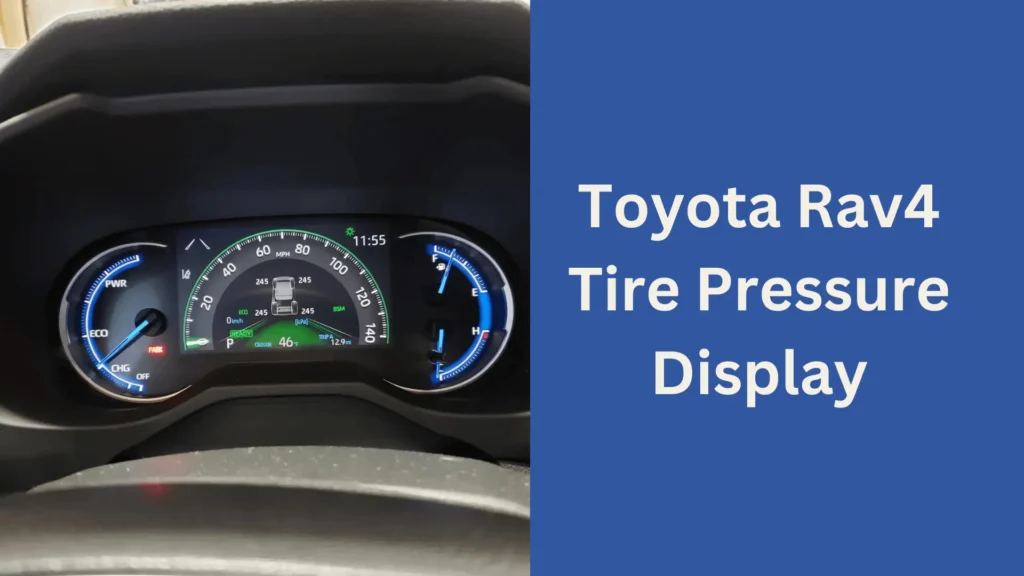Maintaining the right tire pressure is crucial because your tires are the only parts of your car that touch the ground. Properly inflated tires help your car grip the road better and improve fuel efficiency.
Luckily, I’ve put together a complete guide specifically on the Toyota Rav4 tire pressure display. It covers everything from how to check your tire pressure, measure it accurately, keep an eye on it regularly, and adjust it to the recommended level.
Displaying Tire Pressure
Checking your Toyota RAV4’s tire pressure is made easy with the Toyota app or the multi-information display. However, whether you can view this information depends on various factors such as the year your car was made, its trim level, and where you live.
For instance, my RAV4 LE from 2021 couldn’t show tire pressure on the display screen but could be accessed through the Toyota app. On the flip side, when I rented a 2022 RAV4 Hybrid Limited, I could check tire pressure both on the display and the app.
Moreover, the availability of this feature might differ by country. For example, many RAV4s in Canada don’t have tire pressure monitoring systems, which means you can’t check tire pressure through the app or display.
Using the Multi-Information Display:
If your RAV4 is equipped with the feature, you can navigate through different screens on the multi-information display using the arrow buttons on your steering wheel. One of these screens may show the tire pressure for each wheel. However, it’s not clear which trim levels offer this feature, which is a bit surprising considering its usefulness.
Using the Toyota App:
The Toyota app is a handy tool for staying connected to your vehicle. You can access features like viewing tire pressure through Toyota’s Connected Services, but you’ll need a free trial or subscription to Service Connect.
Here’s how to set it up:
- Download the application and sign up for a fresh account.
- Verify your account using the activation code sent to your email.
- Enter your RAV4’s details, either by scanning the VIN or entering it manually.
- Complete the setup process by confirming your vehicle and dealership, reviewing the connected services trials, and agreeing to the terms and conditions.
Once set up, you can easily check your RAV4’s tire pressure through the app, ensuring your tires are always at the right level for safe driving.
You should also check: Toyota Rav4 Brake Fluid Guide (All Models)
Alternative Methods for Checking Tire Pressure:
If you prefer a more traditional approach to car maintenance and don’t want to rely on digital solutions, there are other methods you can use to keep tabs on your tire pressure. Here are a couple of options that I find convenient:
1. Use an Air Pressure Gauge:
An air pressure gauge is a simple tool that provides an accurate reading of your tire pressure. It’s handy to have because you should check your tire pressure every few months, especially when the weather changes significantly or before long trips.
For the most precise reading, check your tire pressure when the tires are cold. This means before you’ve driven your car for the day. Cold temperatures can cause tire pressure to drop temporarily due to the air inside the tire condensing. However, as you drive, the tires heat up, and the pressure increases again.
I recommend keeping an AstroAI digital tire pressure gauge in your glovebox. It’s reliable, easy to use, and doesn’t take up much space.
2. Wait for the Tire Pressure Light:
If you don’t want to invest in an air pressure gauge or use the app, you can rely on the RAV4’s low air pressure warning light. This light will illuminate your dashboard when your tire pressure drops significantly. However, it may take some time for the light to come on, as your tires need to be critically low on air before it activates.
Keep in mind that the warning light may only display a symbol, rather than the actual tire pressure reading. Also, in colder weather, the TPMS warning light might come on due to the temporary drop in tire pressure. If it doesn’t turn off as you drive, there might be an actual issue with your tire that needs addressing.
Determining the Right Tire Pressure
Setting the correct tire pressure is important for safe driving. But figuring out what PSI (pounds per square inch) to set your tires to doesn’t have to be a hassle.
Here’s how to find the recommended tire pressure:
- Start by opening the driver’s side door of your car.
- Look for a sticker on the inside edge of the door frame. This sticker contains important information about your vehicle, including the recommended tire pressures.
- Take note of the PSI values listed on the sticker. These values will vary depending on factors like the make and model of your car, as well as the size of your tires.
By following these simple steps, you can quickly and easily determine the right tire pressure for your vehicle without having to search through the owner’s manual. This ensures that your tires are properly inflated for optimal performance and safety while you’re on the road.
Adjusting Tire Pressure
Setting the right tire pressure for your Toyota RAV4 is simple and won’t cost you a dime!
Here’s what you’ll need:
- A portable tire inflator or air compressor
- Alternatively, you can use the air pumps available at most gas stations (often free).
Another handy option is to keep a portable inflator in your car’s trunk. These are compact and extremely useful, especially if you’ve had experiences like mine where gas station air compressors didn’t work even after taking your money!
For a reliable and budget-friendly choice, I recommend the AstroAI tire inflator. It operates by plugging it into your car’s lighter plug.
Now, let’s go through the steps to set your RAV4’s tire pressure:
If using a Gas Station Air Pump:
- Set the desired pressure on the pump.
- Unscrew the cap from the tire’s valve stem and secure it in a safe place.
- Attach the air hose to the valve and push down until you hear air inflating the tire.
- Hold the pump in place until it beeps, indicating that the desired pressure is reached.
If using an Air Compressor:
- Hold the air compressor in place for a few seconds, then manually check the tire pressure.
- If it’s still low, continue filling until it’s correct.
Replace the Valve Cap:
- Once the tire pressure is correct, put the valve cap back in place.
Repeat for Other Tires:
- Repeat these steps for any other tires that need adjusting.
By following these straightforward steps, you can ensure that your RAV4’s tires are properly inflated, promoting better fuel efficiency, tire longevity, and overall safety on the road.
Low Tire Pressure Risk
- Reduced Handling and Control: When your tires are underinflated, it can affect your vehicle’s handling and control, especially during maneuvers like turning or braking. This increases the risk of accidents, particularly in emergencies where quick responses are crucial.
- Increased Stopping Distance: Underinflated tires require a longer distance to come to a complete stop. This can be dangerous, particularly in situations where you need to brake suddenly to avoid a collision.
- Tire Damage and Wear: Low tire pressure can cause uneven wear on your tires, leading to premature tire failure. It also makes your tires more susceptible to damage from road hazards like potholes and sharp objects, increasing the likelihood of flats and blowouts.
- Reduced Fuel Efficiency: Underinflated tires cause increased rolling resistance, requiring your engine to exert more effort to propel the vehicle forward. This leads to decreased fuel efficiency and ultimately higher fuel costs.
- Overheating: When tires are underinflated, they flex more as they roll, generating heat. This heat buildup can cause tire damage and potentially lead to a blowout, especially at high speeds or under heavy loads.
- TPMS Malfunction: Many modern vehicles are equipped with Tire Pressure Monitoring Systems (TPMS) that alert drivers to low tire pressure. However, if your tires are consistently underinflated, it can cause the TPMS sensors to malfunction or provide inaccurate readings, leaving you unaware of potential tire issues.
To avoid these risks, it’s essential to regularly check your tire pressure and ensure that it’s at the recommended level specified by your vehicle manufacturer.
Conclusion
In conclusion, staying aware of your Toyota RAV4’s tire pressure is vital for safe driving. Whether you rely on the display in the Toyota app or the multi-information display, or prefer traditional methods like using a tire pressure gauge, maintaining proper tire pressure ensures better handling, fuel efficiency, and overall vehicle performance. Regular checks and adjustments can help prevent accidents, extend tire lifespan, and save you money on fuel and repairs in the long run.

